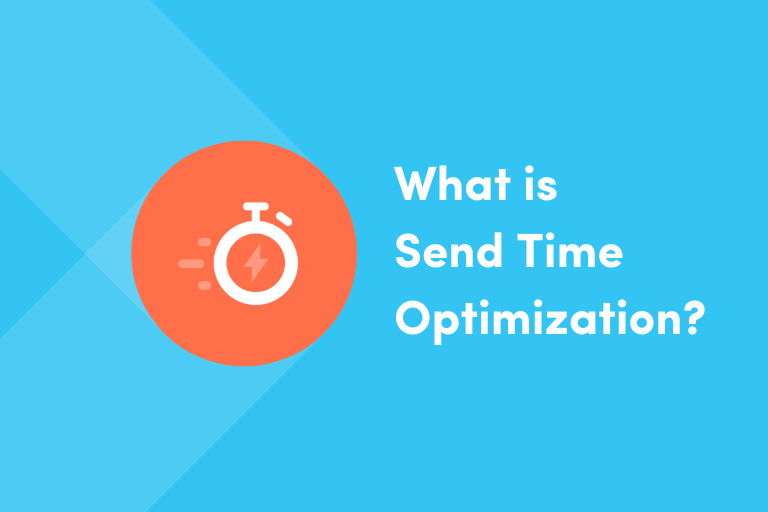Send time optimization refers to the practice of dynamically sending marketing messages—emails, push notifications, etc.—at the time that recipients are most likely to engage with them. With a traditional approach, marketers might consider when most customers in a segment are most likely to open and engage with their communications. But that one-size-fits-all approach still means many individuals are receiving communications at times they may be far less likely to engage.
Instead, send time optimization, as a concept, uses data science and artificial intelligence to automatically find the ideal time to send emails or notifications to each customer. By taking into account individual behaviors, such as usage patterns and open times, the tool can send a message when contacts are most likely to be looking at their inbox or glancing at their phone. That’s a powerful and effective way to bolster the odds of engagement.
How Does Iterable’s Send Time Optimization (STO) Work?
Iterable’s Send Time Optimization (STO) feature—part of Iterable’s AI Suite—relies on a target market’s engagement data. As every marketer knows, there’s no shortage of data when it comes to crafting and sending email campaigns. But, analyzing that data to produce actionable insights requires machine learning—unless you want to do it manually. Behind the scenes, STO uses real-time AI to analyze individual behaviors, like usage patterns and open times. The tool then predicts an optimal time to send a marketing message so that the message reaches the individual at a time they are most likely to see and engage with it.
The more data an AI tool has about an individual, the more refined that timing can become. STO aggregates data across a customer’s entire lifecycle. That means optimized send times aren’t set in stone. As an individual’s behavior shifts over time, the real-time AI tool captures and integrates that new data into the overall analysis. More recent data is more heavily weighted than historical data.
Engagement is the overarching goal when it comes to marketing communications and when to send them. However, specific metrics vary by platform. For email campaigns, Send Time Optimization tries to maximize two metrics: the open rate (calculated by comparing the unique opens or clicks to the total number of emails delivered) and the click rate (calculated by comparing the unique email clicks to the total emails delivered). For push notification campaigns, STO focuses on maximizing the open rate metric (calculated by comparing the unique pushes opened to the total pushes delivered).
Benefits of Send Time Optimization
Think of STO as the next evolution of marketing. In the early days of email marketing, for example, sending communications was a fairly manual process, and timing was based on a best guess. As email marketing matured, marketers pushed past generic email rules—like aiming for midweek or mid-morning messages—to create segmented lists. They would then target those segments by time zones or through strategies like A/B testing to vary email delivery and increase engagement.
STO takes that refinement even further. For example, two people on a segmented marketing list may share an incredible amount of overlap—from demographics to buyer’s journeys, engagement levels to brand loyalty—and still have dramatically different behaviors in terms of when they engage with their marketing communications. Send Time Optimization takes the guesswork out of timing marketing communications by using real data and powerful machine learning to target every customer as individuals.
While STO doesn’t guarantee higher engagement, it can increase the likelihood that messages will be sent and received at times when individuals are most likely to open and engage with those marketing messages. And there’s no question that reaching individuals when they’re most receptive to messages is a powerful differentiator in the world of marketing.
Send Time Optimization as Part of a Cross-Channel Campaign
Cross-channel marketing is all about connecting with customers across a cohesive customer journey—and sustaining that brand engagement as they move from passing contact to brand loyalist. Send time optimization can help drive home those goals, with minimal marketing effort.
How? Well, personalization is paramount when sending marketing communications. But that doesn’t only mean the marketing content should be tailored to the recipient. By also personalizing exactly when a message is sent to the individual, it’s possible to foster more (and more meaningful) connections between your brand and the customer. Rather than get lost in the slew of messages, a marketer can reach the top of someone’s inbox exactly when they’re most likely to be opening up their email. And push notifications can shift from generic, blasted sends to a more personalized delivery cadence that feels more useful and relevant. It can even help an individual feel seen and understood by the brand.
Given the number of marketing channels available, reaching an individual on the right channel and at the right time can be challenging. By leveraging the power of AI, Iterable’s Send Time Optimization makes it that much easier for marketers to personalize delivery and, ultimately, engage the people they’re trying to reach.
If you’re interested in learning more about STO, reach out to your CSM or schedule a demo today.

































